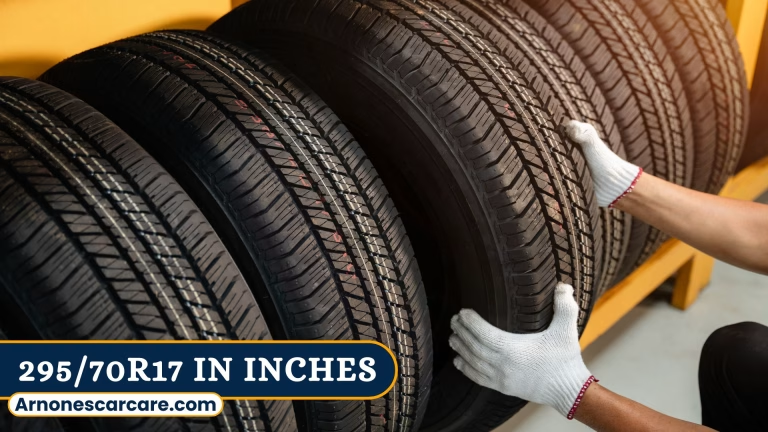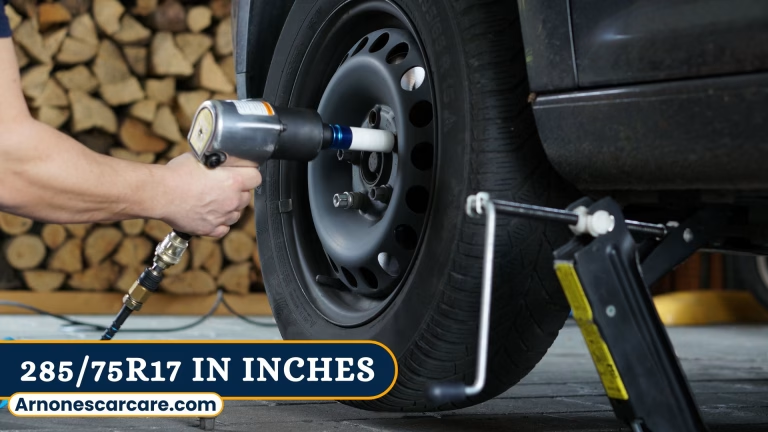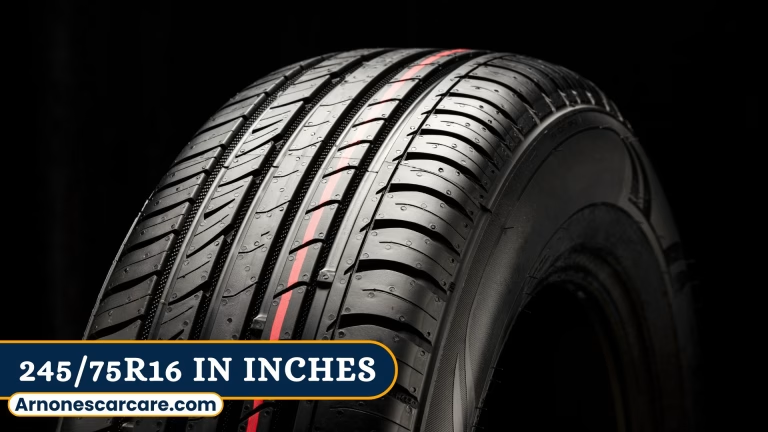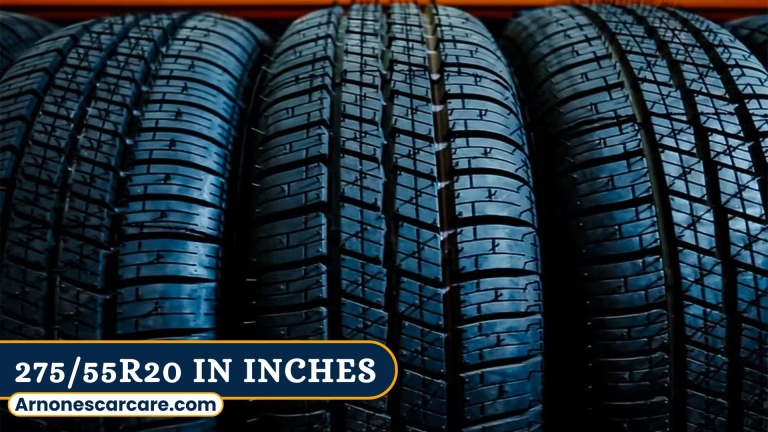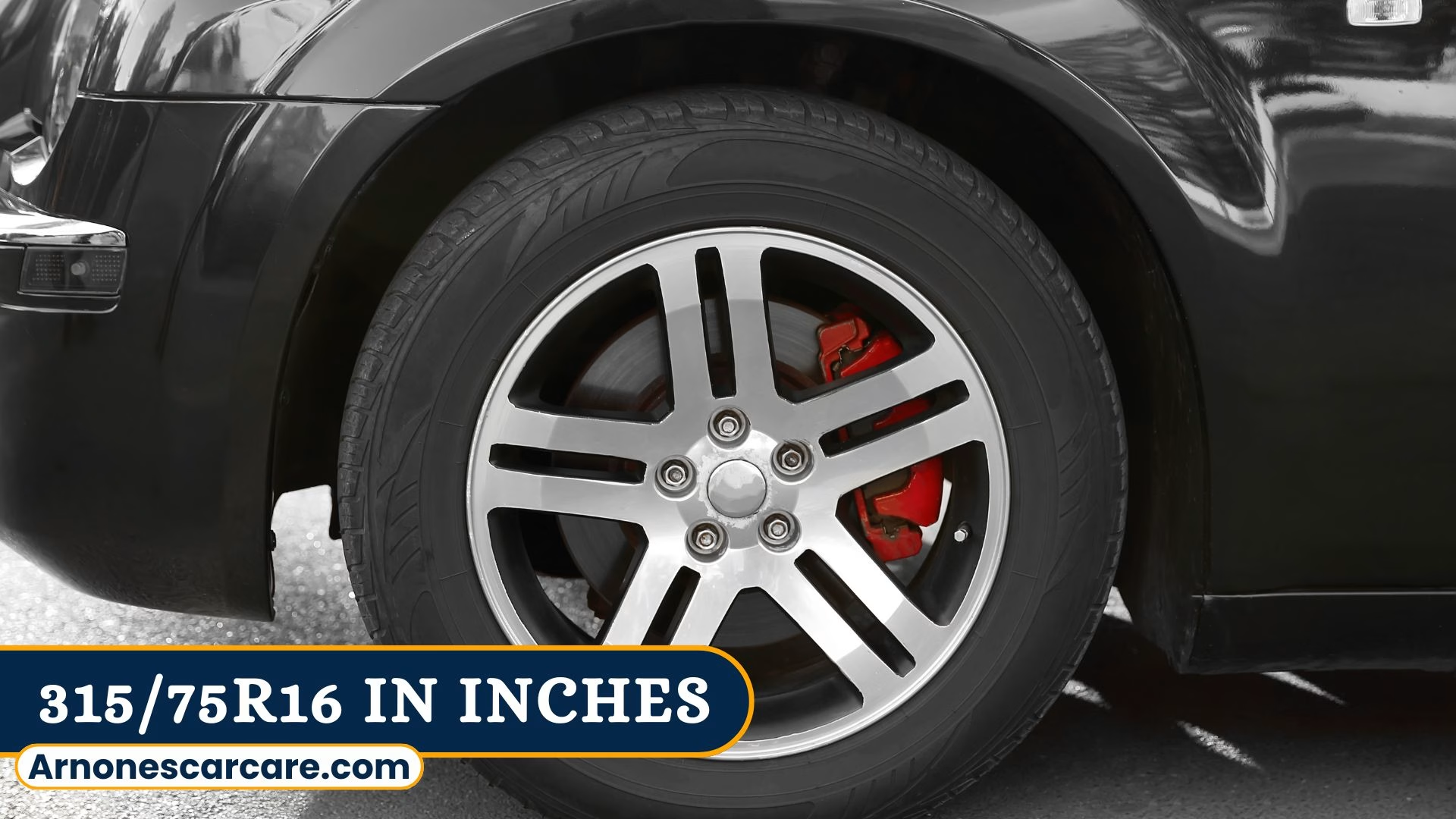
When it comes to tackling rugged terrain with confidence, the 315/75R16 tire size stands out as a top choice for off-road enthusiasts and truck owners. With its commanding 34.6-inch overall diameter, 12.4-inch width, and 9.3-inch sidewall, this tire offers impressive ground clearance, enhanced traction, and a bold stance that looks as tough as it performs.
Whether you’re cruising highways with a loaded trailer or carving through muddy trails on the weekend, the 315/75R16 tire is engineered for both function and flair. It strikes a fine balance between off-road capability and daily drivability, especially when paired with the right suspension lift and wheel setup.
In this guide, you’ll learn everything you need to know about the 315/75R16 tire: from exact specs and rim fitment to lifespan, speed ratings, and alternatives. This breakdown will help you confidently choose whether this size fits your driving needs—and your vehicle. You can also check out my other blog posts covering different tire sizes to help you make smarter choices.
What Does 315/75R16 Mean?
The code 315/75R16 provides crucial information about a tire’s dimensions, construction, and fitment. Let’s break it down:

- 315: This is the tire’s width in millimeters. A width of 315 mm (≈ 12.4 inches) means the tire is broad, giving it a larger contact patch with the road. This enhances traction, especially on rough or off-road surfaces.
- 75: This number is the aspect ratio, which shows the sidewall height as a percentage of the tire’s width. In this case, 75% of 315 mm gives a sidewall height of about 236 mm (9.3 inches). A taller sidewall adds more cushioning and improves ride comfort—especially useful when driving over rocks, mud, or uneven ground.
- R: The “R” stands for Radial construction. Radial tires have internal layers running perpendicular to the direction of travel, making them stronger, more flexible, and longer-lasting than older bias-ply designs.
- 16: This refers to the diameter of the wheel (in inches) that the tire is designed to fit. So, a 315/75R16 tire mounts on a 16-inch rim.
Actual Dimensions of 315/75R16 in Inches and mm
Understanding the exact dimensions of your 315/75R16 tires is crucial whether you’re upgrading for off-road performance or seeking better stance and traction. This tire size is known for its large diameter, aggressive width, and tall sidewalls—perfect for trucks, SUVs, and rugged terrain explorers. Here’s a detailed breakdown of its specs in both inches and millimeters.
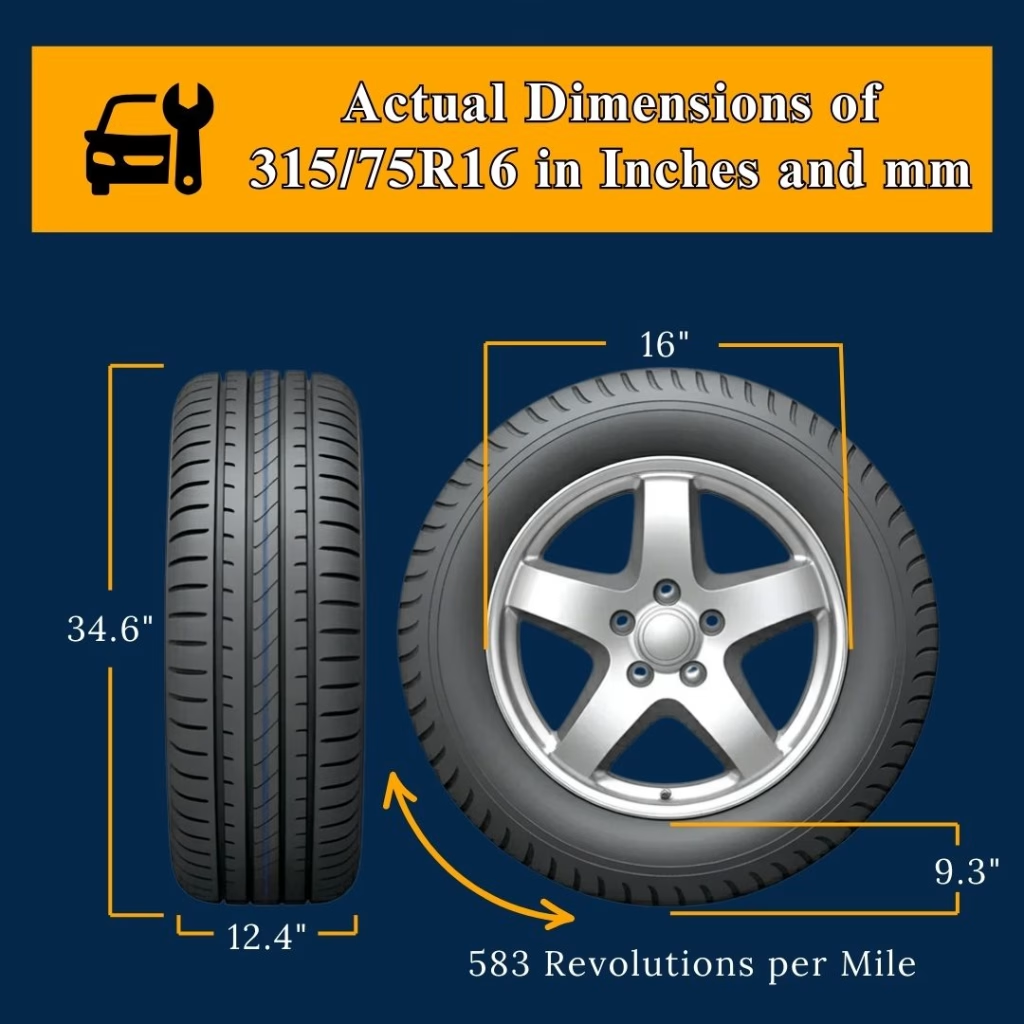
| Feature | Inches | Millimeters |
| Overall Diameter | 34.6″ | 878 mm |
| Tread Width | 12.4″ | 315 mm |
| Sidewall Height | 9.3″ | 236 mm |
| Wheel Diameter | 16″ | 406.4 mm |
| Circumference | 108.6″ | 2756.9 mm |
| Revs/Mile | 583 | 363/km |
These specs deliver a commanding stance, better off-road capability, and a smoother ride on uneven surfaces, thanks to the taller sidewalls.
How to Convert 315/75R16 Into Inches?
To understand the dimensions of a 315/75R16 tire in inches, follow these simple steps:
- Width: Convert 315 mm to inches by dividing by 25.4:
315 ÷ 25.4 = 12.4 inches
This gives you the total tread width of the tire. - Sidewall Height: Multiply the width by 0.75 (75% of the width):
12.4 × 0.75 = 9.3 inches
This is the height of one sidewall from the rim to the outer tread. - Overall Diameter: Add the sidewall height (top and bottom) to the wheel diameter (16 inches):
9.3 × 2 + 16 = 34.6 inches
This is the full height of the tire from ground to top tread. - Circumference: Multiply the diameter by π (3.14):
3.14 × 34.6 = 108.6 inches
This helps determine revolutions per mile and affects speedometer readings.
These calculations confirm the tire’s key specs:
✔️ 12.4 inches wide
✔️ 34.6 inches tall
✔️ 108.6 inches in circumference
This size offers excellent ground clearance and a bold stance—perfect for off-road builds and lifted trucks.
How Long Will 285/65R18 Tires Last?
Most 285/65R18 tires last between 20,000 to 60,000 miles, depending on how you use and care for them. But even if they aren’t fully worn out, they should be replaced after 6 years—and never used beyond 10 years from the manufacturing date.
Here’s a simplified breakdown to help you understand what affects their life:
Key Factors That Affect Tire Life
- Mileage vs. Age
- Tires wear down from both driving and simply getting older.
- Some get worn from use, others weaken with time even if unused.
- Tires wear down from both driving and simply getting older.
- Tire Type Matters
- Highway tires: last longer (up to 60,000+ miles).
- All-terrain or mud tires: wear faster (20,000–40,000 miles).
- Highway tires: last longer (up to 60,000+ miles).
- Driving Style
- Hard braking, fast driving, towing, and off-roading shorten tire life.
- Smooth driving helps them last longer.
- Hard braking, fast driving, towing, and off-roading shorten tire life.
- Regular Maintenance
- Check tire pressure monthly.
- Rotate every 5,000–7,000 miles.
- Balance and align your wheels regularly.
- Check tire pressure monthly.
- Environmental Conditions
- Heat, UV rays, and poor storage cause rubber to crack and age.
- Store tires in cool, dry places to prevent early damage.
- Heat, UV rays, and poor storage cause rubber to crack and age.
Tire Care Tips for Longer Life
- Drive gently and avoid sharp turns or sudden stops.
- Avoid heavy loads unless tires are rated for them.
- Use highway tires for everyday driving if off-roading isn’t needed.
- Keep tires properly inflated.
- Replace tires on time, even if they look okay.
Is 315/75R16 a 35-Inch Tire?
Technically, 315/75R16 is not a true 35-inch tire, but it comes very close. With an actual overall diameter of 34.6 inches, it’s just 0.4 inches shorter than a labeled 35-inch tire. That small difference might seem negligible, which is why many off-road enthusiasts and tire shops casually refer to it as a “35.”
However, for precise vehicle fitment—especially on stock suspension setups or tight wheel wells—that slight difference can matter. It can affect speedometer accuracy, clearance, and suspension articulation, so measurements should always be checked before installation.
Tire Speed Ratings Explained
Speed ratings define the tire’s max safe speed capacity under optimal conditions.
Here’s a breakdown:
| Rating | Max Speed | Common Use |
| Q | 100 mph | Off-road tires, light trucks |
| R | 106 mph | Vans, medium trucks |
| S | 112 mph | Sedans, light SUVs |
| T | 118 mph | Minivans, family cars |
For 315/75R16, Q and R ratings are most common, which means they prioritize strength and grip over high-speed performance—ideal for towing or trail use.
What Rim Size is Required for 315/75R16?
Choosing the right rim size for your 315/75R16 tires is crucial for safety, performance, and overall tire life. Mounting these wide tires on an incompatible rim can lead to poor handling, uneven wear, or even tire failure—especially during off-road driving. Here’s a quick breakdown of the ideal rim widths and why they matter.

- Minimum Rim Width: 8 inches: This is the narrowest width you should use. It’s safe, but might cause the tire to look slightly “bulged.”
- Maximum Rim Width: 11 inches: This is the widest recommended width. Going beyond this can stretch the tire too much.
- Sweet Spot (Best Fit): 9 to 10 inches: This range keeps the tire stable, helps it wear evenly, and improves both on-road and off-road performance.
Why Rim Width Matters:
Here are some key reasons why rim width plays a critical role when fitting 315/75R16 tires:
- A narrow rim can cause too much sidewall flex, making the ride feel squishy.
- A wide rim can make the ride rougher and expose the rim to damage during off-roading.
Bottom Line: Stick to 8″–11″, aim for 9″–10″, and make sure the wheel style fits your vehicle and driving style.
How It Affects Speedometer and Gearing?
Speed readings drop and gear ratios get affected. With a larger tire, your speedometer may under-report your actual speed. For example, if you switch from 265/75R16 to 315/75R16:
- At an indicated 60 mph, your actual speed is about 65–66 mph.
- Your RPMs at cruising speed will drop, which could reduce torque performance.
To offset this, many off-roaders re-gear their differentials after upsizing.
How 315/75R16 Compares to Other Sizes: Key Differences
Choosing the right tire size often comes down to performance needs, comfort, and clearance. Here’s how 315/75R16 compares with other popular alternatives in off-road and all-terrain setups.
315/75R16 vs 285/75R16: Width vs Versatility
| Specification | 315/75R16 | 285/75R16 | Key Differences |
| Width | 12.4 inches | 11.2 inches | 315/75R16 is wider, offering more grip. |
| Sidewall Height | 9.3 inches | 8.4 inches | Taller sidewalls improve cushioning off-road. |
| Overall Diameter | 34.6 inches | 33.8 inches | Slightly taller, better ground clearance. |
| Revs per Mile | 583 | 614 | 285/75R16 rotates more, slightly better MPG. |
Verdict: Go with 315/75R16 for more aggressive looks and off-road traction. Choose 285/75R16 for slightly better fuel economy and easier fitment on stock trucks.
315/75R16 vs 305/70R16: Height vs Fitment
| Specification | 315/75R16 | 305/70R16 | Key Differences |
| Width | 12.4 inches | 12.0 inches | Very close in width. |
| Sidewall Height | 9.3 inches | 8.4 inches | 315/75R16 has more sidewall cushioning. |
| Overall Diameter | 34.6 inches | 33.8 inches | 315 is taller, improving off-road clearance. |
| Revs per Mile | 583 | 613 | 305/70R16 rotates more frequently. |
Verdict: 305/70R16 is easier to fit on stock suspension. 315/75R16 is better for lifted setups focused on clearance and durability.
315/75R16 vs 35×12.50R16: Technical vs True 35s
| Specification | 315/75R16 | 35×12.50R16 | Key Differences |
| Width | 12.4 inches | 12.5 inches | Nearly identical in width. |
| Sidewall Height | 9.3 inches | 9.3 inches | Same ride height and comfort. |
| Overall Diameter | 34.6 inches | 35.0 inches | 35s are slightly taller. |
| Revs per Mile | 583 | ~579 | Very small difference in performance. |
Verdict: 35×12.50R16 is a true 35-inch tire, while 315/75R16 is often labeled as 35” but is slightly shorter. Either works great for off-road performance; choose based on brand and tread options.
What vehicles can use 315/75R16 tires?
315/75R16 tires are most commonly used on heavy-duty trucks, lifted SUVs, and off-road-ready 4x4s that require added ground clearance, wide tread for grip, and reinforced load capacity.
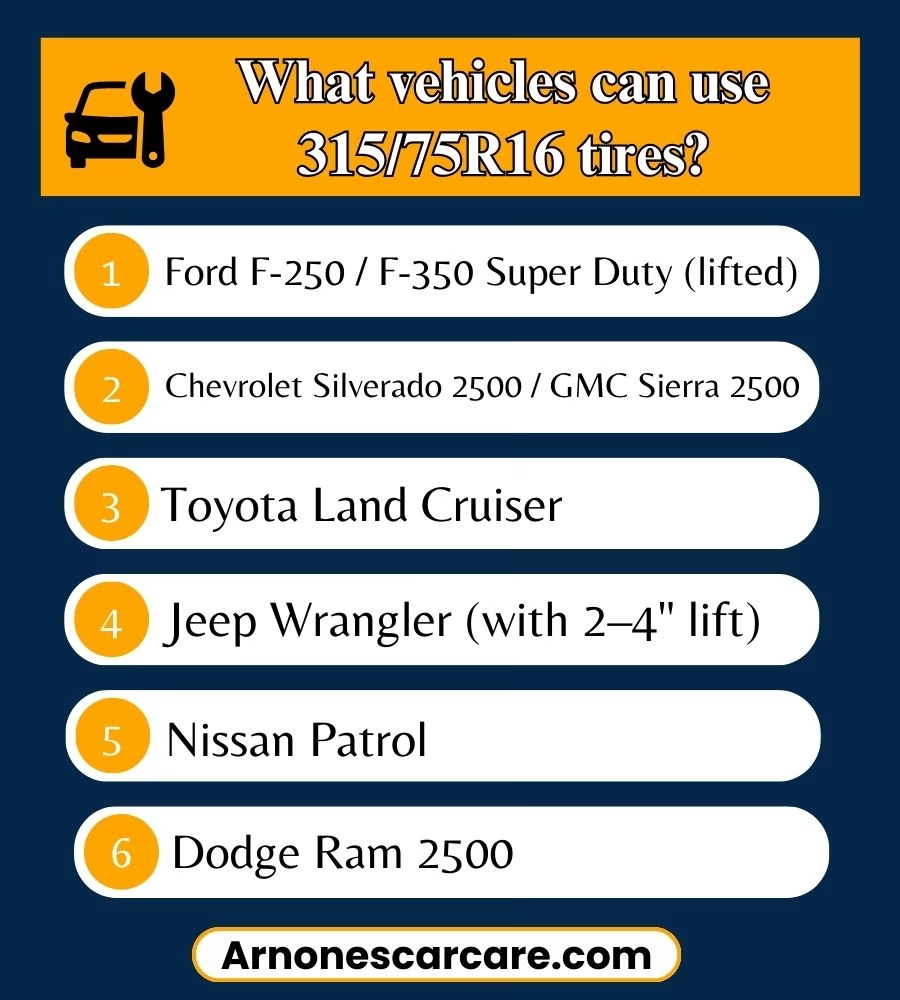
Popular Vehicles with 315/75R16 Tire Fitment:
- Ford F-250 / F-350 Super Duty (lifted)
- Chevrolet Silverado 2500 / GMC Sierra 2500
- Toyota Land Cruiser
- Jeep Wrangler (with 2–4″ lift)
- Nissan Patrol
- Dodge Ram 2500
Why This Size Works Well:
- The wide footprint offers increased traction and stability in off-road conditions like mud, sand, and rocky trails.
- Tall sidewalls improve shock absorption and reduce the risk of rim damage on rough terrain.
- 16-inch wheel compatibility makes it ideal for drivers who prefer more sidewall flex and lower risk of wheel damage during off-roading.
This tire size is perfect for drivers who tackle trails, haul heavy loads, or simply want an aggressive look paired with reliable performance.
Fitment Tips and Buyer Considerations
Upgrading to 315/75R16 tires requires careful planning to ensure proper fit and performance.
- Suspension Lift Required: Most vehicles need a 2–4 inch lift to fit 315/75R16 tires without rubbing.
- Wheel Width Compatibility: Best suited for rims between 8 to 10 inches wide.
- Speedometer Calibration: Larger diameter may affect speedometer accuracy—recalibration is recommended.
- Fuel Economy Impact: Heavier tires can slightly reduce MPG, especially on smaller engines.
- Braking & Acceleration: Expect minor performance changes due to increased rotational mass.
- Clearance Check: Ensure enough space in fender wells, especially during full turns or articulation.
- Ideal for Off-Road Builds: These tires are commonly used on modified 4x4s and lifted trucks for maximum traction.
Alternative Tire Sizes Similar to 315/75R16
Looking for a close match? These tire sizes have less than 3% diameter variation and may work as replacements:
| Size | Diameter | Width |
| 285/75R18 | 34.8″ | 11.2″ |
| 305/70R18 | 34.8″ | 12.0″ |
| 295/65R20 | 35.1″ | 11.6″ |
| 325/65R18 | 34.6″ | 12.8″ |
| 305/55R22 | 35.2″ | 12.0″ |
These alternatives are great for different wheel sizes without sacrificing performance or looks. You can also take advantage of our professional tire repair services to ensure your tires stay in top condition.
Frequently Asked Questions (FAQs)
Q. How many revolutions per mile does a 315/75R16 tire make?
Approximately 583 revolutions per mile. This is essential for speedometer calibration and understanding the effect on fuel efficiency and drivetrain wear.
Q. Is it suitable for daily driving?
Yes—with the right alignment and tire type. An all-terrain version of this tire offers smooth highway performance. However, expect a slight drop in fuel economy and an increase in road noise compared to smaller sizes.
Q. What is the recommended rim width for 315/75R16?
These tires best fit rims between 9″ to 10″ wide for balanced performance.
The safe range is 8″ (minimum) to 11″ (maximum).
Q. Can I use 315/75R16 on a stock truck?
Not without modifications—a 2–4 inch lift is usually required to avoid rubbing.
Fender trimming or proper wheel offset may also be necessary.

